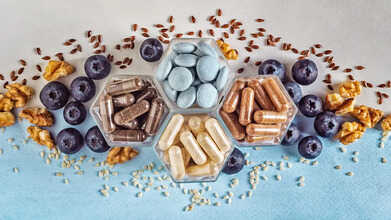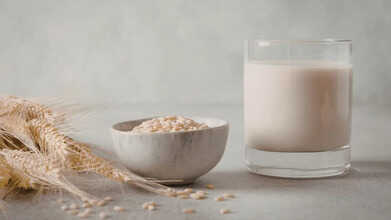- Health Conditions A-Z
- Health & Wellness
- Nutrition
- Fitness
- Health News
- Ayurveda
- Videos
- Medicine A-Z
- Parenting
These Everyday Foods Are Causing Your Worst Smelliest Farts

Credits: Canva
Let’s face it—there’s no polite way to talk about farts. Yet, every single one of us does it, and sometimes, the smell can clear a room faster than a fire alarm. Medically known as flatus, this bodily function is entirely natural. However, the odor intensity often triggers embarrassment, confusion, or concern. So why do some farts smell worse than others? The surprising culprit often lies in our daily diet.
Although they're a part of daily life, flatulence is still a mystery to most people. This article goes in-depth into the biology behind gas, gut bacteria, and more importantly, how your ordinary foods you consume may be turning your farts appallingly smelly—despite them being otherwise healthy.
Flatulence is the ultimate product of a multifaceted digestive process. When we eat, it's digested in multiple stages. But some carbohydrates pass through the stomach and small intestine unabsorbed. These carbs travel to the colon, where there exists an enormous community of bacteria—particularly from the phylum Firmicutes—willingly fermenting them.
The process of fermentation yields a combination of gases like hydrogen, methane, and carbon dioxide, which are largely odorless. However, when foods that contain sulfur are fermented, the bacteria emit hydrogen sulfide, a strong-smelling compound with a rotten egg odor.
Surprisingly, nearly 99% of all gas in the intestines is odorless, but it's that 1%—usually sulfur compounds—that produces malodors. Interestingly, the amount of gas isn't really relative to the strength of its odor.
Foods Behind Foul-Smelling Farts
Below is the list of typical foods that might be behind your worst gas—and the reasons why.
1. Cruciferous Vegetables
Broccoli, cauliflower, cabbage, and Brussels sprouts are fiber and antioxidant powerhouses, but they contain sulfur compounds and insoluble carbs in abundance. When gut bacteria are indulged on these difficult-to-digest sugars, they emit hydrogen sulfide, leading to gas with a rotten egg or sulfur-like odor.
This does not mean that you should exclude these vegetables from your diet—they're great for hormone balance and detoxification. However, if you eat them in huge amounts without moderation, they can transform your gut into a gas chamber.
2. Beans and Legumes
Beans have been joked about for years for their gas-producing properties, and science confirms it. Beans, lentils, and peas contain raffinose and stachyose, sugars that our bodies do not have the enzyme to break down. These arrive in the colon undigested and offer rich fuel for bacteria, which create a combination of methane and sulfur gases during fermentation.
Legumes are healthy and a must in plant-based meals, but if they are well soaked before preparation and mixed with digestion-friendly spices such as ginger or cumin, their gassy effect afterwards can be minimized.
3. Whole Grains
Whole wheat bread, oats, and bran are loaded with insoluble fiber, promoting digestive health. But because this fiber resists digestion, it gets fermented in the colon—producing gas. The good news? Your body can adjust. If you’re increasing your fiber intake, do it gradually and drink plenty of water. For every 5 grams of added fiber, up your fluid intake by 8 ounces to prevent bloating and smelly gas.
4. Milk Products
Milk, cheese, and yogurt have lactose, a sugar that most adults cannot digest easily because they have low lactase enzyme levels. For people who are lactose intolerant, this unabsorbed lactose is fuel for gas-producing bacteria, sometimes causing smelly flatulence.
If you think that dairy is the problem but don't want to eliminate it from your diet, use lactose-free versions or lactase tablets and observe whether your symptoms get better.
5. Apples, Bananas, and Peaches
These innocent-looking snacks have fructose and sorbitol, natural sugars that can lead to gas in sensitive people. Healthy in moderation, they can lead to stink when the body is not able to fully digest them, especially if the composition of your gut microbiome is more susceptible to these fermentable sugars.
6. Protein Overload
Protein is important for muscle repair and growth, but overconsumption—particularly from protein powders, bars, and meats—is stressing the digestive system. Excess protein that the body isn't able to absorb in the small intestine gets fermented by colonic bacteria, which release volatile sulfur compounds responsible for particularly pungent emissions.
Follow the daily recommended intake: roughly 0.8 grams of protein per kilogram of body weight, unless a doctor says otherwise.
Flatulence is enormously different from one individual to another. Two people might have the same same meal and have utterly different results, all due to variations in gut microbiome, enzyme function, food intolerance, and medical conditions such as irritable bowel syndrome (IBS) or lactose intolerance.
Medical professionals observe that unless flatulence is greatly impacting your life, there's no cause for alarm. Farting, even the stinky variety, indicates a healthy digestive system. But if you have ongoing bloating, abdominal pain, or a sudden change in bowel movements, it's best to seek the advice of a healthcare provider.
Stinky farts may be embarrassing, but they're also giving you a message about your digestive system. It's not about cutting out fiber, beans, and protein, but learning how to balance your consumption, fuel your gut with water and probiotics, and pay attention to your body's response. So, the next time you break one out, don't just fault the broccoli. Fault the bacteria—and perhaps reconsider that third bowl of lentil soup.
RFK Jr.’s New Food Pyramid vs Old Food Pyramid: Know What All Has Changed In Dietary Guidelines For Americans

Credits: Canva/Politico
The U.S. Department of Agriculture (USDA) rolled out a new set of dietary guidelines on Wednesday, Jan. 7, introducing a food pyramid that looks strikingly different from what most people remember. Emphasizing protein and healthy fats while reducing the role of grains, the updated recommendations represent a clear break from previous federal guidance. The accompanying food pyramid graphic almost completely reverses the old model, both in appearance and in the food groups it promotes.
During a White House briefing, Press Secretary Karoline Leavitt highlighted the changes, saying the announcement aligned with President Donald Trump and Health Secretary Robert F. Kennedy Jr.'s mission to "Make America Healthy Again."
If you’re used to the pyramid from the early 2000s, it may take a moment to adjust to the new look. Here are some of the major differences between the old and new food pyramids.
New Food Pyramids 2026: What Does The New Food Pyramid Look Like?
The U.S. had stopped using the pyramid as a guide back in 2011, switching to a plate-style visual for dietary recommendations. Now, under RFK Jr.’s leadership at HHS, the pyramid is back—but flipped. The upside-down triangle now places the foods that should make up most of your diet at the top, while foods to eat sparingly sit at the bottom.
RFK Jr.’s New Food Pyramid vs Old Food Pyramid
It’s not just the graphic that’s changed. The hierarchy of food groups has shifted as well. Grains, once the largest and foundational part of the diet, are now the smallest segment at the bottom. Meanwhile, protein, dairy, healthy fats, fruits, and vegetables dominate the top of the pyramid.
Here’s a detailed look at RFK Jr.’s New Food Pyramid vs Old Food Pyramid and what it means for Americans, based on reporting from USA Today.
1. Focus Shift
Old Food Pyramid: Grains and carbs were the base, while proteins and fats were limited. The focus was on low-fat foods and staples like bread, pasta, and cereal.
RFK Jr.’s New Food Pyramid: Whole foods, protein, and healthy fats take center stage. Red meat, cheese, fruits, and vegetables are placed at the top, and refined grains play a smaller role.
2. Protein and Fats
Old: Saturated fats and animal proteins were discouraged. Fat was often treated as the main dietary enemy.
New: Protein and healthy fats, including saturated fats from meat and dairy, are now seen as essential. Federal nutrition leaders have officially declared an end to the “war on fat.”
3. Processed Foods
Old: Highly processed foods, added sugars, refined carbs, and chemical additives were allowed in moderation.
New: There’s a strong push to reduce ultra-processed foods, added sugars, and refined carbs. The emphasis is now on minimally processed, real foods.
4. Dairy
Old: Low-fat or skim dairy was recommended; full-fat options were generally discouraged.
New: Cheese and other dairy products are now at the top of the pyramid, allowing for full-fat milk in both general diets and school meals.
5. Sugar and Additives
Old: Sugar intake was suggested to be limited, but highly processed foods weren’t heavily flagged.
New: Added sugar is more strictly controlled, and processed foods are clearly marked as foods to minimize.
6. Overall Approach
Old: The diet centered on lowering fat, balancing calories, and relying heavily on plant-based staples such as grains.
New: The focus is on nutrient-rich, protein-heavy meals, healthy fats, whole foods, and cutting down refined carbohydrates. The guidelines aim to address obesity, chronic disease, and overall health.
How Does The New Pyramid Reflect Dietary Trends?
The new food pyramid, unveiled by Health Secretary Robert F. Kennedy Jr., signals a major shift in U.S. nutrition advice, emphasizing more protein and healthy fats while reducing grains. This change mirrors growing trends in American diets, where high-protein eating patterns and skepticism of high-carb, ultra-processed foods are increasingly common, according to USA Today.
Practically, protein and dairy, especially full-fat dairy, now dominate the pyramid, replacing the previous grain-heavy base. Saturated fats are no longer demonized; instead, they are considered healthy in moderation. Federal nutrition leaders have officially ended the “war on fat.” These updates also reflect recent survey findings showing that high-protein diets are a top trend in the U.S., with most Americans actively trying to increase their protein intake.
Supplements, Gummies, Or Whole Foods? Here’s What Experts Recommend

Credits: Canva
In a world where colourful vitamin gummies line supermarket shelves and powders promise instant wellness, many people are left wondering: should I really rely on supplements, or is eating well enough? Experts say the answer isn’t as simple as choosing one over the other.
Why Natural Foods Come First
Dr. Hari Kishan Boorugu, Consultant Physician and Diabetologist at Yashoda Hospitals, Hyderabad, emphasizes that “whole, natural foods should always come first.” Fruits, vegetables, whole grains, nuts, seeds, fish, yogurt, and healthy oils are packed with vitamins, minerals, fibre, antioxidants, and other plant compounds that work together to support digestion, immunity, heart health, and gut microbiome balance. “Supplements can’t fully replicate the synergy of nutrients found in real foods,” he adds.
Supplements, including tablets, capsules, powders, and even gummies—are meant to fill specific gaps. They are particularly useful for people with diagnosed deficiencies, dietary restrictions, pregnancy-related needs, ageing-related bone health, or medical conditions that affect nutrient absorption. But Dr. Boorugu cautions that “self-prescribing or overusing supplements can lead to nutrient imbalances or even toxicity, especially with vitamins A, D, E, and K.”
The Truth About Gummies
Gummies have become popular for their taste and convenience. Yet, experts warn that they are not a substitute for a balanced diet. “Many gummies contain added sugar and inconsistent doses of nutrients,” Dr. Boorugu explains. They can support your nutrition, but only when used responsibly and under medical guidance.
Supplements As Support, Not Shortcuts
Ruchika Rajbans, Founder & CEO of Arechar Group and creator of Vitagoli, says people often ask her, “Do I really need supplements? Isn’t eating well enough?” Her answer: ideally, yes—food should cover your nutritional needs—but real life often interferes. Stress, lack of sleep, overworking, and hormonal changes can affect how well your body absorbs nutrients.
“Supplements are gap fillers, not meal replacements,” Ruchika explains. “Whether in gummies, tablets, or powders, what matters is the quality of the ingredients and whether there’s evidence backing their benefits.” She adds that wellness isn’t about chasing trends or formats; it’s about understanding your body, reading labels carefully, and making informed choices.
Experts agree that balance is key. Prioritize a varied, nutrient-rich diet, maintain a healthy lifestyle, and use supplements only when necessary, preferably with medical guidance. Real nutrition starts on your plate—not in a capsule or gummy.
What Is ‘Oatzempic’? TikTok’s New Weight-Loss Trend Explained

Credits: Canva
If you scroll through TikTok or Instagram these days, chances are you have come across videos of people blending oats with water or juice and calling the drink “oatzempic”.
The term is clearly inspired by Ozempic, a prescription drug mainly used to treat type 2 diabetes and known for reducing appetite. Clips featuring the oat-based drink often promise quick weight loss, long-lasting fullness, and a “natural substitute” for medication. But does oatzempic have any scientific backing? In short, no. Here’s a closer look at why.
What Is Oatzempic?
There is no fixed formula for oatzempic. Most videos show people blending one or two tablespoons of rolled oats with a glass of water. Some add lemon or lime juice, cinnamon, or soak the oats beforehand. Oats are high in beta-glucan, a form of soluble fibre that turns gel-like when mixed with liquid. The idea is that drinking this mixture will help you feel full and curb hunger.
Many TikTok creators suggest replacing breakfast with oatzempic. Others recommend drinking it mid-afternoon to avoid overeating later.
Oatzempic: What Happens When You Drink It?
As per The Independent, many people online say they feel fuller after drinking oatzempic, which makes sense. Oats contain beta-glucan, a soluble fibre that forms a thick gel in the digestive tract. This slows digestion and can increase feelings of fullness. Strong evidence shows that diets rich in viscous soluble fibre, such as that found in oats, can modestly improve appetite control, blunt blood sugar spikes after meals, and support healthier cholesterol levels.
That said, oats are not unique in this respect. Foods like apples, citrus fruits, flaxseeds, barley, psyllium husk, and legumes such as beans and lentils also contain soluble fibres that behave in a similar way in the gut, promoting fullness and overall health. So yes, oats can help you feel satisfied. But feeling full alone does not equal lasting or meaningful weight loss.
Sustainable weight management depends on balanced eating and regular physical activity, not just appetite suppression.
Has Oatzempic Actually Been Studied For Weight Loss?
No. There are no clinical studies examining the “oatzempic drink” for weight loss, appetite regulation, or long-term health effects. There is no agreed recipe, no standard quantity, and no research following its use over time.
If someone loses weight while drinking it, it is difficult to know whether that change is due to oatzempic itself, reduced calorie intake overall, or other lifestyle adjustments happening at the same time.
Oatzempic: Are There Downsides To Consider?
For most people, drinking small amounts of oatzempic is unlikely to be harmful. Still, there are a few points worth keeping in mind:
- It is not a complete meal. Oatzempic lacks adequate protein, healthy fats, and several essential nutrients. Regularly replacing meals with it could lead to nutrient deficiencies or under-eating
- Increasing fibre too quickly can cause discomfort. People who are not used to high-fibre diets may experience bloating or digestive issues, particularly if they are not drinking enough fluids
- The name itself can be misleading. Calling it “oatzempic” encourages comparisons with a prescription drug, which may wrongly suggest it has similar effects
- It may delay proper care. Relying on a viral drink instead of seeking evidence-based nutrition or medical advice could stop people from getting the support they actually need.
© 2024 Bennett, Coleman & Company Limited

